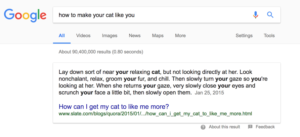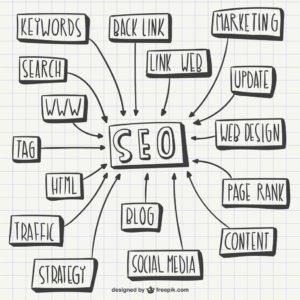Brace yourselves, we’ve reached the acronyms.

Search Engine Optimisation, also referred to as SEO by the marketing elite, is the process of getting traffic from the search results on search engines. This process increases online visibility of a website using a search engine’s unpaid results, often “organic” or “earned” results. Think of it as looking for a place to eat fried chicken – you’ll probably choose between the first two you see instead of traveling all around Singapore to find other options. SEO works in the same manner; it helps online businesses to boost their online presence by being the first few websites consumers stumble upon. It also attracts the maximum number of visitors to keep the profit pouring in. Going back to the fried chicken analogy, it doesn’t matter if your fried chicken is flown from Greece, peppered with smoked sesame seeds and delicately fried in truffle oil. If it’s in a terribly inaccessible place, you will have very few customers. Likewise, even if a website has a beautiful design, the most attention-grabbing copy, and amazing offers, it won’t thrive without an effective SEO strategy.
Now that we’ve established why SEO is so vital to a business, let’s talk about how. If brands want to venture into SEO, they should be armed with a well-defined and targeted strategy to effectively drive traffic to their site.
How to Build an Effective SEO Strategy
- Go Google it!
The world’s most popular search engine according to Net Marketshare, is Google. So it would only makes sense for businesses to increase visibility on Google’s many platforms such as Google Search, Google Maps, and Google+, and this can be done via signing up for Google My Business Service.
- You can find me on Twitter, Instagram, Facebook, LinkedIn, Myspace…
Creating profiles on various social media sites will allow you to build a strong social presence, and this is important if you want your website to rank high in the search engine result page. By increasing your social media fan base and directing users to your website via embedded links, you are effectively directing a greater number of online visitors to your website. This is because search engines take cue about the online search results from the popularity of websites.
- Better UX, better results
Ah yes, UX… That tricky concept that everyone talks about but only few can master. But how does it relate to SEO? By having a website that is appealing to consumers and easy to navigate, you will improve user experience and ensure that users spend more time browsing your website. This in turn helps improve conversion rates, reduce bounce rates and boost search engine rankings.
- A snippet goes a long way
Another aspect of SEO that links closely to UX is featured snippets a.k.a the best thing to ever happen to search engines. A quick search on something and it’s right there, no clicking on links required. My thumb has never been so grateful.
Essentially, featured snippets show a quick summary of an answer to a user’s search query. They are displayed at the top of the search results page, commonly referred to as position #0. It enhances visibility for two reasons; first, consumers will notice it as it’s right on the top and second, your website has the opportunity to appear twice on the first page of the search results. However, businesses need to research on the most optimal formats for featured snippets that will effectively answer search query, whether it be lists, tables or any other. Rob Bucci, CEO and founder of STAT Search Analytics, highlights that the introduction of featured snippets by Google was to streamline user experience, and will play an increasingly important role in years to come.

- Keeping Up with The Kontent
People are always craving new information. Whether it’s a new service in nutrigenomics or the lip colour that Kylie Jenner sported at the Met Gala, people want to be constantly updated. The same goes for consumers. By regularly updating the content on your website, you’re keeping your customers coming back for more. Even the Google Caffeine algorithm update that was released eons back in 2010 favours sites that have regular content updates.
- Click the link
A linkable asset is quite simply put, an asset that your target audience is interested in and therefore, worth linking to. For many online retailers, that would mean their landing page (think ASOS, Urban Outfitters and Lazada). Linkable assets are important to an e-commerce SEO strategy because the basis of SEO is building links. The presence of interesting and shareable content with relevant links can vastly spike your ranking position.
- Behind enemy lines
And speaking of links, having a look at your competitors’ backlinks can be fruitful to your own business. It allows you to discover patterns, problems and opportunity that have already been built by your competitors, simply by analyzing theirs. It’s like hitching a ride from someone that already knows the way, when you know nothing (Jon Snow).
- Understand your customers
On a whole, marketing and advertising is about knowing know what consumers want and giving it to them. In the field of SEO, businesses can better understand their customers using two methods. One, community engagement – an effective e-commerce SEO tactic that allows businesses to better understand your consumers, specifically their concerns and their interests. As such, businesses need to be present on platforms where their target audience spend the most time on. And two, guest posting – while community management is the listening ear, guest posting is the speaking podium. Guest posting allows businesses to gain awareness of their brand and speak directly to their customers, all the while building quality relationships. In addition, it also helps to establish you as an expert in your field and increase referral traffic.
SEO is a huge concept with many different arms, each with their own concerns and nuances. And if I had explored each of them here, this article would be a book. Instead, this article aimed at giving a quick introduction into the world of search engine optimization. And in case it flew over your head, here’s a quick graphic summary:

(Source: Freepik.com)
Give us a holla at hello@alto.sg for a free consultation. We’ll be glad to help you out![/et_pb_text][/et_pb_column][/et_pb_row][/et_pb_section]

